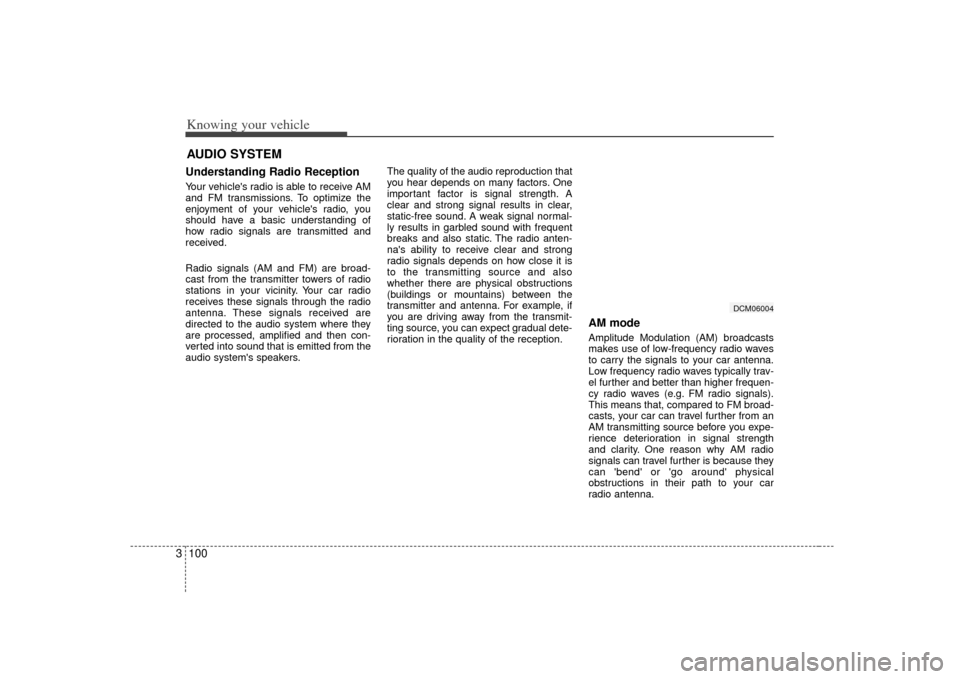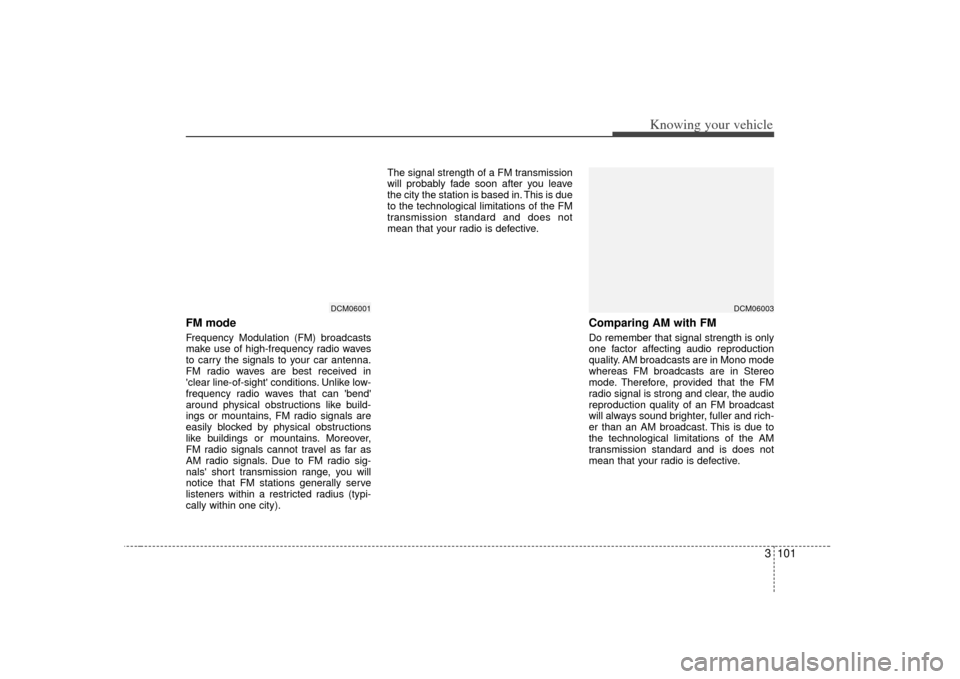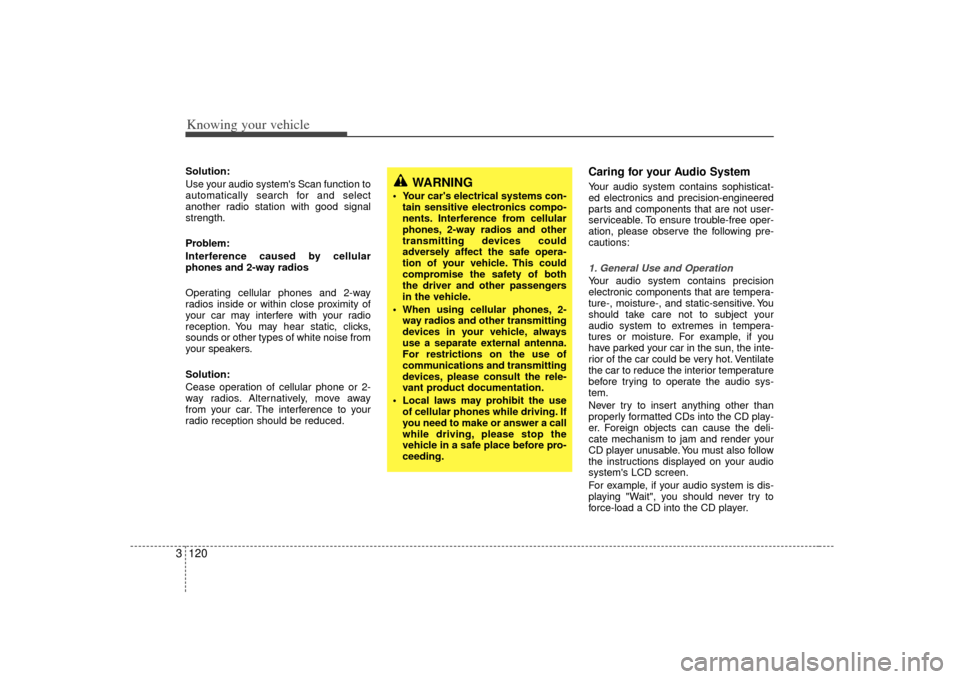radio antenna KIA Sorento 2007 1.G Owner's Manual
[x] Cancel search | Manufacturer: KIA, Model Year: 2007, Model line: Sorento, Model: KIA Sorento 2007 1.GPages: 325, PDF Size: 5.01 MB
Page 109 of 325

Knowing your vehicle100
3AUDIO SYSTEMUnderstanding Radio ReceptionYour vehicle's radio is able to receive AM
and FM transmissions. To optimize the
enjoyment of your vehicle's radio, you
should have a basic understanding of
how radio signals are transmitted and
received.
Radio signals (AM and FM) are broad-
cast from the transmitter towers of radio
stations in your vicinity. Your car radio
receives these signals through the radio
antenna. These signals received are
directed to the audio system where they
are processed, amplified and then con-
verted into sound that is emitted from the
audio system's speakers. The quality of the audio reproduction that
you hear depends on many factors. One
important factor is signal strength. A
clear and strong signal results in clear,
static-free sound. A weak signal normal-
ly results in garbled sound with frequent
breaks and also static. The radio anten-
na's ability to receive clear and strong
radio signals depends on how close it is
to the transmitting source and also
whether there are physical obstructions
(buildings or mountains) between the
transmitter and antenna. For example, if
you are driving away from the transmit-
ting source, you can expect gradual dete-
rioration in the quality of the reception.
AM mode Amplitude Modulation (AM) broadcasts
makes use of low-frequency radio waves
to carry the signals to your car antenna.
Low frequency radio waves typically trav-
el further and better than higher frequen-
cy radio waves (e.g. FM radio signals).
This means that, compared to FM broad-
casts, your car can travel further from an
AM transmitting source before you expe-
rience deterioration in signal strength
and clarity. One reason why AM radio
signals can travel further is because they
can 'bend' or 'go around' physical
obstructions in their path to your car
radio antenna.
DCM06004
Page 110 of 325

3 101
Knowing your vehicle
FM mode Frequency Modulation (FM) broadcasts
make use of high-frequency radio waves
to carry the signals to your car antenna.
FM radio waves are best received in
'clear line-of-sight' conditions. Unlike low-
frequency radio waves that can 'bend'
around physical obstructions like build-
ings or mountains, FM radio signals are
easily blocked by physical obstructions
like buildings or mountains. Moreover,
FM radio signals cannot travel as far as
AM radio signals. Due to FM radio sig-
nals' short transmission range, you will
notice that FM stations generally serve
listeners within a restricted radius (typi-
cally within one city).The signal strength of a FM transmission
will probably fade soon after you leave
the city the station is based in. This is due
to the technological limitations of the FM
transmission standard and does not
mean that your radio is defective.
Comparing AM with FMDo remember that signal strength is only
one factor affecting audio reproduction
quality. AM broadcasts are in Mono mode
whereas FM broadcasts are in Stereo
mode. Therefore, provided that the FM
radio signal is strong and clear, the audio
reproduction quality of an FM broadcast
will always sound brighter, fuller and rich-
er than an AM broadcast. This is due to
the technological limitations of the AM
transmission standard and is does not
mean that your radio is defective.
DCM06001
DCM06003
Page 129 of 325

Knowing your vehicle120
3Solution:
Use your audio system's Scan function to
automatically search for and select
another radio station with good signal
strength.
Problem:
Interference caused by cellular
phones and 2-way radios
Operating cellular phones and 2-way
radios inside or within close proximity of
your car may interfere with your radio
reception. You may hear static, clicks,
sounds or other types of white noise from
your speakers.
Solution:
Cease operation of cellular phone or 2-
way radios. Alternatively, move away
from your car. The interference to your
radio reception should be reduced.
Caring for your Audio SystemYour audio system contains sophisticat-
ed electronics and precision-engineered
parts and components that are not user-
serviceable. To ensure trouble-free oper-
ation, please observe the following pre-
cautions:1. General Use and OperationYour audio system contains precision
electronic components that are tempera-
ture-, moisture-, and static-sensitive. You
should take care not to subject your
audio system to extremes in tempera-
tures or moisture. For example, if you
have parked your car in the sun, the inte-
rior of the car could be very hot. Ventilate
the car to reduce the interior temperature
before trying to operate the audio sys-
tem.
Never try to insert anything other than
properly formatted CDs into the CD play-
er. Foreign objects can cause the deli-
cate mechanism to jam and render your
CD player unusable. You must also follow
the instructions displayed on your audio
system's LCD screen.
For example, if your audio system is dis-
playing "Wait", you should never try to
force-load a CD into the CD player.
WARNING
• Your car's electrical systems con-
tain sensitive electronics compo-
nents. Interference from cellular
phones, 2-way radios and other
transmitting devices could
adversely affect the safe opera-
tion of your vehicle. This could
compromise the safety of both
the driver and other passengers
in the vehicle.
When using cellular phones, 2- way radios and other transmitting
devices in your vehicle, always
use a separate external antenna.
For restrictions on the use of
communications and transmitting
devices, please consult the rele-
vant product documentation.
Local laws may prohibit the use of cellular phones while driving. If
you need to make or answer a call
while driving, please stop the
vehicle in a safe place before pro-
ceeding.